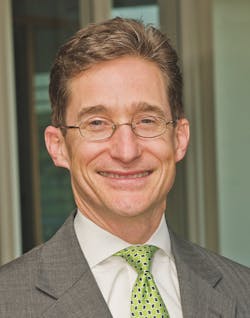Fall and Re-Fall
Benjamin H. Grumbles is president of the Clean Water America Alliance. Views expressed in this column may not necessarily reflect those of the Alliance or its members. Grumbles can be reached at [email protected].
Visit www.cleanwateramericaalliance.org for more information about the Clean Water America Alliance.
“The leaves change
And so do I.
They fall to the ground,
And I fall to the sky.
Apple and cinnamon,
Swirl all around.
Beneath my feet,
A crunching sound.
A death of the past,
A birth of the new.
Pumpkin patches,
Fields to run through.
An endless circle,
And mistakes to mend.
Beginning to beginning,
And end to end.”
—Anna Ferguson, Age 11
Wexford, Pa., River of Words contest 2010 finalist
Anna’s poem, “Fall,” reminds me of seasonal rhythms and the “endless circle” of life, water and learning. Utility managers, water professionals and amateur water watchers understand the basics of the hydrologic cycle. But how often do we see society’s water policies and practices aligning with water’s reality? We have a lot of room for improvement.
Clean Water America Alliance, the national nonprofit charitable organization I’m president of, promotes a “one water” philosophy that instills a more holistic, integrated approach to water and watersheds. Our annual urban water sustainability leadership conference, Oct. 3 to 5, 2011, in Milwaukee, highlighted the work of cities embracing the one water approach, particularly through green infrastructure and resource recovery. Visit our website to learn more about this watershed event and watch inspiring presentations by multidisciplinary public-private teams and urban leaders from Los Angeles; Seattle; Cincinnati; Austin, Texas; and Louisville, Ky., as well as previous winners from Philadelphia, New York, Washington state, Milwaukee, San Francisco and the Portland, Ore., area.
Green infrastructure, like the leaves in Anna’s poem, can come in many different shades and colors, ranging from green roofs and rain gardens to bioswales, urban parks and more. These systems or practices use or mimic natural processes to infiltrate, evapotranspirate or reuse storm water and runoff on the site where it is generated.
The Alliance’s “Barriers and Gateways to Green Infrastructure” report (September 2011) was made possible by a grant from the Turner Foundation and a highlight of the recent urban water sustainability conference. It documents real-world pitfalls and possibilities for a softer path to managing storm water and sewer overflows and realizing the triple-bottom-line benefits of protecting the environment, saving money and advancing social goods (e.g., beautifying neighborhoods and empowering citizens). More than 200 respondents to our national survey described technical/physical, legal and regulatory, financial and institutional/cultural barriers at the local, regional and federal levels. More than half of the respondents cited energy and cost savings as motivation for replacing traditional approaches with newer, greener “slow-it-down, spread-it-out, soak-it-in” techniques. Turns out, money does grow on trees.
Risk and uncertainty are threads running through virtually all of the barriers. Examples: the lack of clarity on definitions, local codes and standards; the need for improved accounting and life-cycle analysis of benefits and costs; the complications of private-property rights and western water laws; the hesitation to design, build and finance untested approaches that may not deliver environmental compliance in the same way or the same timeframe as more conventional techniques; and the lack of integration among competing offices and programs, particularly groundwater permitting and transportation and parking-related agencies. Some of the key recommendations in the report: The U.S. Environmental Protection Agency should use its upcoming Clean Water Act storm water regulations to drive green infrastructure practices with performance-based standards that give states and localities the flexibility they need to tailor solutions to their local communities and regional watersheds.
Like green infrastructure, resource recovery also comes in many shades and shapes. It can involve the mining of wastewater, sludge and manure for energy and nutrients, heat and fuel. Technologies are available to recapture and reuse the nutrients in America’s waste streams, such as by diverting food scraps from landfills and sending them instead to wastewater treatment/energy generation plants as well as recovering phosphorus and ammonia from wastewater to create useful products for growing food and plants. Urban systems are increasing their efforts with combined heat, power and biogas projects to reduce energy costs and greenhouse gas emissions.
Our water future depends on changing some of the old paradigms, such as shifting to more green and less gray and making resource recovery the norm. The Milwaukee Metropolitan Sewerage District reminded conference attendees that words as well as actions matter: Paradigms begin to shift when the public thinks and speaks of wastewater treatment plants as water reclamation facilities and centers of regeneration rather than refuse discharge points. Businesses and agencies look for opportunities to reuse and recycle, green and grow.
Our wise 11-year-old poet also reminds us that the journey matters too and inevitably will include “mistakes to mend.” Water practictioners and policy-makers must learn and relearn, adapt and grow. Green infrastructure and resource recovery projects will involve some trial and error. Crusty, crunchy old habits don’t change overnight and technical, legal and cultural barriers aren’t overcome in a week. It takes a season.
Download: Here
